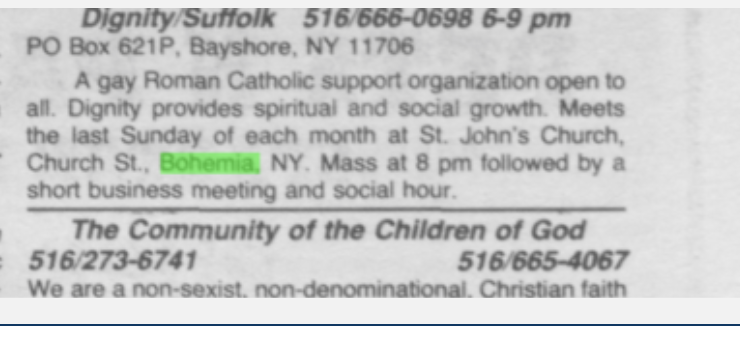A Hotel in Bohemia
So many of the entries in Bob Damron Address Books appear unremarkable. (I mean, not all bars can have a history like Stonewall, right?) The vast majority of listings in the gay guides don’t provide much context or historical information, and so it requires historians and the wider public to give meaning to these lists of addresses. But even if wider context doesn’t always lead to cinematic stories of police raids or resistance, it doesn’t mean we can’t learn more about queer life in America through these guides.
Sometimes the sole listing from a certain city catches our team’s attention. What better place to look for ignored queer history than focusing on cities that so many of us might think is devoid of LGBTQ life and culture. For this vignette, let’s take a brief look at Bohemia, New York.
At first glance, Bohemia seems like a place that should have plenty of queer history. The hamlet sits just fifty miles from New York City and close to the coastal tourist towns of Long Island. Just an hour drive away is Fire Island Pines and Cherry Grove, a historical vacationing landmark for gays and lesbians that began in the early part of the twentieth century.
But despite this mere proximity to the bustling queer neighborhoods of Fire Island and the Big Apple, Bohemia doesn’t have too many entries in the guidebooks over the years we’ve currently processed (from 1965 until 1980). Unlike other towns in Long Island (especially on the coast), Bohemia rarely brought in straight or queer tourists in major numbers in these years. So why, then, did our researchers see a random hotel listed as a spot for gay travelers in three years in the early 1970s?

Figure 1. The Central Hotel, Compliments of the Bohemia Historical Society
At first glance, the listing itself doesn’t lead us to any groundbreaking discoveries. The entry, the Central Hotel, is listed with little information in the Damron guides, with a street address at 1290 Smithtown in three years of 1970—1972. In the 1970 listing of the Central Hotel, Damron included a “D” amenity, suggesting that it was common for dancing to take place within the establishment.
The presence of hotels in Bohemia has also caught the attention of others, including historians at the Connetquot Public Library in Bohemia. After conducting oral histories with locals, the library team discovered that beyond lodging, the hotels of Bohemia were especially used for “social gatherings such as balls, dances, celebrations, fraternal organization meetings, weddings, or just for a meal or pint of beer.”1 In the first half of the twentieth century, tourist buses from New York City bussed in hundreds of people (especially Czech Americans) to eat hotels that served the famous Czech local cuisine, which included dumplings, pork, and delicious sauerkraut. Until the 1950s, locals and tourists could enjoy a pork or duck dinner at the Central Hotel, with live music and plenty of dancing, what some dubbed a “good-time night.”
Our friends over at the Connetquot Public Library have made several of their oral histories of this early hotel entertainment culture in Bohemia available to public:
Figure 2. Bohemia local Gloria Rysanek shares her memories of the Central Hotel.
It appears the Central Hotel eventually acquired new ownership in the 1960s, and apparently burned down in a fire in the 1980s. But what was happening at the Central Hotel that apparently made it a gay hangout in the early 1970s (according to the Damron guides)? We can’t be quite sure, but it’s possible that the hotel still regularly hosted dance nights that attracted a gay following. One hint can be found in the history of another nearby hotel—the Sunrise. By 1970s, as disco music took America by storm, hotels like the Sunrise became sites of booming discotheque clubs. It’s altogether possible that the Central Hotel attracted gay nightlife seekers in the Bohemia hamlet.
Bohemia’s LGBT history extends far beyond the Central, which is a reminder to us that the gay guides can’t tell us everything we need to know about queer past. For example, we know from gay and lesbian newspapers that by the 1980s (past the currently available data on Mapping the Gay Guides), the Suffolk branch of the gay Catholic group Dignity began meeting at the St. John’s Church in Bohemia, evidence of a queer religious community in the hamlet.

Figure 3. Dignity/Suffolk advertisement, The Connection/L.I. Connection, April 14, 1983, pg. 45
The Central Hotel listing here is a fabulous example of how a random, unremarkable listing in the gay guides can lead to some pretty fascinating historical understandings. We still don’t’ know what made the Central Hotel “gay” in the early 1970s. Was there a disco club on site? Did it draw up gay tourists from Cherry Grove? Did locals find a hotel the most accepting place in their hamlet? Or perhaps the hotel’s queer legacy stretches back to the time of those good-night nights and plenty of Czech cuisine?
Our queer historical quest continues.
-
“The Hotels of Bohemia, New York,” Memory Lane, Connetquot Public Library. Accessed January 13, 2021. ↩︎